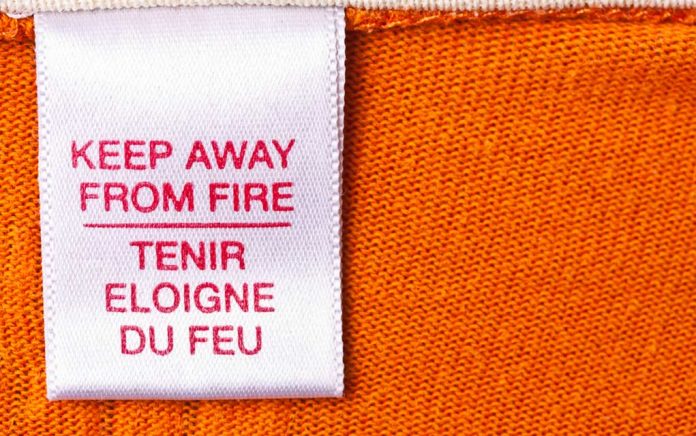
Fire is both a life-saving tool and a dangerous force of nature capable of destroying nearly everything in its path. This includes homes, automobiles, campers and the people residing within them. There are a few ways to reduce a person’s risk of being engulfed in flames, however, and it starts with the very clothes they wear.
So, how do wool, cotton and other common household fabrics hold up against fire? Read on to find out.
Inspecting Your Clothes
To determine how a certain article of clothing is going to react to fire, look at the tag. Most clothing tags will state:
- Flammable, inflammable or combustible, meaning the clothing will catch on fire easily.
- Fireproof, non-flammable or non-combustible, meaning the clothing will only catch on fire if the temperature surpasses a certain level.
- Fire or flame resistant/retardant, meaning the clothing will be slow to ignite, slow to burn or potentially self-extinguishing after the heat source is removed.
Not all clothing will have a tag with these labels. If in doubt, consider it flammable. Also, these labels can sometimes be inaccurate for a number of reasons. You need to also look at the clothing itself as certain designs are more susceptible to catching fire. Fabrics with lighter and looser weaves tend to catch fire easier due to there being more oxygen around the fibers.
Building off of the lighter and looser fabrics, clothing with fluffy, furry, plush, loose and other pile type fabrics ignite easier for the same reason, the lighter and looser weave making more oxygen available. Even the design of the clothing itself may make it more or less flammable. Long, loose-fitting clothes are more likely to catch fire than tight clothing — again, because more oxygen is available. Also, long and loose clothing may drape dangerously close to heat sources without the person wearing them realizing.
Cotton vs Wool
Both of these materials are very popular in the clothing industry. Yet, they are far from equal when it comes to flammability. Cotton, while sometimes treated with flame retardants, can be a real hazard around fire. Flame retardants lower the chances of ignition significantly, but their use can also cause serious health problems.
Wool, on the other hand, has a higher flame resistance than cotton, but it will still burn. Fire doesn’t melt wool, but it does shrink the fabric as it ignites. It’s easy to know when wool catches on fire as it has the same awful smell as burning hair. Wool is typically self-extinguishing after the heat source is removed.
Other Materials
Polyester is a man-made synthetic material that dominates many homes. It’s in clothes and furniture and serves as reinforcement in belts, hoses, and tires. When exposed to fire, polyester both burns and melts at the same time, making it especially dangerous to a person wearing this material. The fabric can melt to your skin, causing serious and painful burns.
Nylon, another artificial fiber, is made up of carbon, oxygen, hydrogen and nitrogen molecules. This stretchy, durable fabric is commonly found in swimwear, athletic clothing and hosiery. Nylon first melts, then it will burn slowly.
Does the Clothing Make a Difference?
In short, the answer is yes, clothing can make a major difference during a fire. However, no matter what material you wear, it will burn eventually; it’s just a matter of how long until it does. Remember that clothing fires aren’t always started by direct exposure to a flame; even prolonged exposure to an indirect heat source can cause clothes to combust. No matter what you choose to wear, you still need to know what to do should your clothes ever catch on fire.
How to React to Your Clothes Being on Fire
If you’re on fire, you have no more than a few seconds to act regardless of what you’re wearing. While it’s true that flame-resistant clothing will keep you safe for a longer period of time, you also risk spreading the fire.
Your first action should be to attempt to remove the clothing. If your clothes are more difficult to take off, stop and drop to the ground then roll to smother the fire. If you’re around someone who catches on fire, and they’re unable to take either of the above steps, you can also use a blanket or jacket to cover them in an attempt to suffocate the fire.
Do you know of any fireproof materials we missed? Have you ever had to use your clothing to put out a fire? Let us know by replying to your email. We would love to hear from you!
Copyright 2021, TheSurvivalGuide.com














